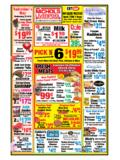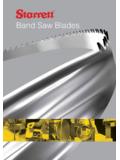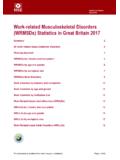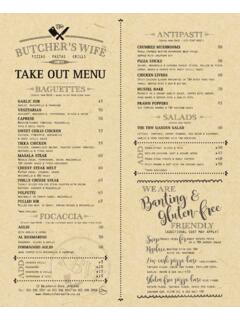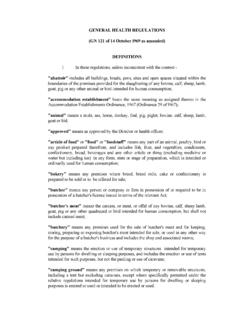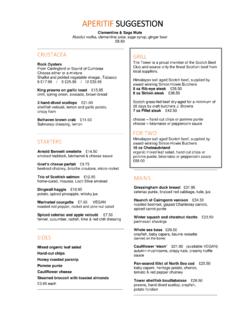Transcription of Example risk assessment for a butcher’s shop
1 Example risk assessment : ButcherThis risk assessment addresses the risks to the owner and his staff from work activities in the shop. It does not cover compliance with food safety and hygiene legislation, information can be found at How was the risk assessment done?The owner followed the guidance in Five steps to risk assessment ( ). 1 To identify the hazards, the owner: looked at HSE s web pages for small businesses, to learn where hazards can occur; walked around the shop, the stockroom and all other areas, noting what might pose a risk and taking HSE guidance into consideration.
2 The owner also considered occasional activities, such as changing light bulbs;talked to staff to learn from their knowledge and experience, and listen to their concerns and opinions about health and safety issues in the shop; looked at the accident book, to understand what previous problems there have been;decided that, on the apprentice s first day at work, they would go through the risk assessment with him and decide what additional risk control measures were necessary, taking account of the apprentice s lack of both experience and awareness of risk.
3 2 The owner wrote down who could be harmed by the hazards and how. 3 For each hazard, the owner wrote down what controls, if any, were in place to manage these hazards. These controls were then compared to the guidance on HSE s website. Where existing controls were not considered good enough, the owner wrote down what else needed to be The owner discussed the findings with staff, displayed the risk assessment in the staffroom and made it part of the induction process for new staff. The owner decided when the actions that were needed would be done, and who would do them, and decided to tick the actions off as each was The owner decided to review and update the risk assessment every year or straightaway if major changes in the workplace happened.
4 Setting the sceneThe owner carried out the risk assessment in this butcher s shop, which is located on a busy high street. The owner employs five people, two of them part-time. The owner will soon be taking on a 17-year-old the rear of the shop is a staff toilet and washing facilities, an area where staff can make hot drinks etc, a cold store and storage space for dry goods. The shop trades from am to pm, six days a risk assessment for a butcher s shop1 of 4 pagesHealth and Safety ExecutiveImportant reminderThis Example risk assessment shows the kind of approach a small business might take.
5 It can be used as a guide to think through some of the hazards in your business and the steps you need to take to control the risks . Please note that it is not a generic risk assessment that you can just put your company name on and adopt wholesale without any thought. This would not satisfy the law and would not be effective in protecting business is different you need to think through the hazards and controls required in your business for and Safety ExecutiveWhat are the hazards?Who might be harmed and how?What are you already doing?What further action is necessary?
6 Action by who?Action by when?DoneManual handling DeliveriesStaff risk strains or other injuries, to their back or elsewhere, from handling carcasses or other staff are trained how to lift properly. High shelves are for light goods only. Walkways kept clear. Porter s trolley available. Carcasses quartered by supplier, prior to delivery. Remind staff that where possible, stock should be moved using the staff of the need to lift properly and safely, particularly when handling and trips Staff/customers risk sprains, fractures or bruising if they trip over objects, such as stock, or slip on spillages, eg from fat build try to stop meat debris/blood getting on the floor drip trays used, leaks on machines are fixed and staff put meat debris straight into clean as they go.
7 Wet floor warning signs always used. Tiled floor even, in good condition and has good drainage. Doormats at entrance in wet weather. Good lighting in all areas. Staff wear sensible, non-slip footwear. Floor in all areas cleaned thoroughly according to a daily schedule. Remind staff to check for ice debris in the cold store and to clear this away. Owner20/7/0719/7/07 Remind staff to clean shoes at end of day and check soles have not worn , mincers, cutters, slicersStaff risk deep cuts or amputations from contact with blades or other machinery machines guarded according to manufacturers instructions.
8 Staff trained in using machines safely, including pre-use checks and safe systems of work for clearing carriers are always used when a blade is removed, and staff are trained to use them signs displayed at machines. Sufficient space provided for operator around machines. Push sticks provided as necessary. Apprentice not to use or clean machinery where there is access to moving staff not to distract colleagues who are using staff to do pre-use checks on machinery guards and to follow the safe system of work for clearing blockages, being especially sure to turn off the machine before doing a closely supervised programme for the apprentice in how to use and clean machinery.
9 Owner20/7/0719/7/07 Company name: Smith s Butchers Date of risk assessment : 1/7/072 of 4 pagesExample risk assessment : ButcherHealth and Safety ExecutiveWhat are the hazards?Who might be harmed and how?What are you already doing?What further action is necessary?Action by who?Action by when?DoneKnivesStaff risk deep cuts or amputations from contact with trained in the safe use, maintenance and storage of knives. Staff use the right knives for the job. Knives kept sharp. PPE (chain mail gauntlet/apron) provided and staff know how to wear it and for what space for staff to work safely.
10 Remind staff not to distract colleagues when they are using that shop first-aiders are trained in first aid for stab risk zoonotic infection from absorbing raw personal hygiene from all staff. Good washing and welfare facilities. Food waste stored in closed containers. Staff trained in washing out puncture wounds and covering cuts with food-grade plasters and staff to clean and disinfect waste buckets every time they are at height Changing light bulbs or displaysFalls from any height can cause stepladder in good condition provided, and staff know how to use it Manager20/7/0717/7/07 Contact with bleach and other cleaning chemicalsStaff doing cleaning risk skin irritation or eye damage from direct contact with cleaning chemicals.










